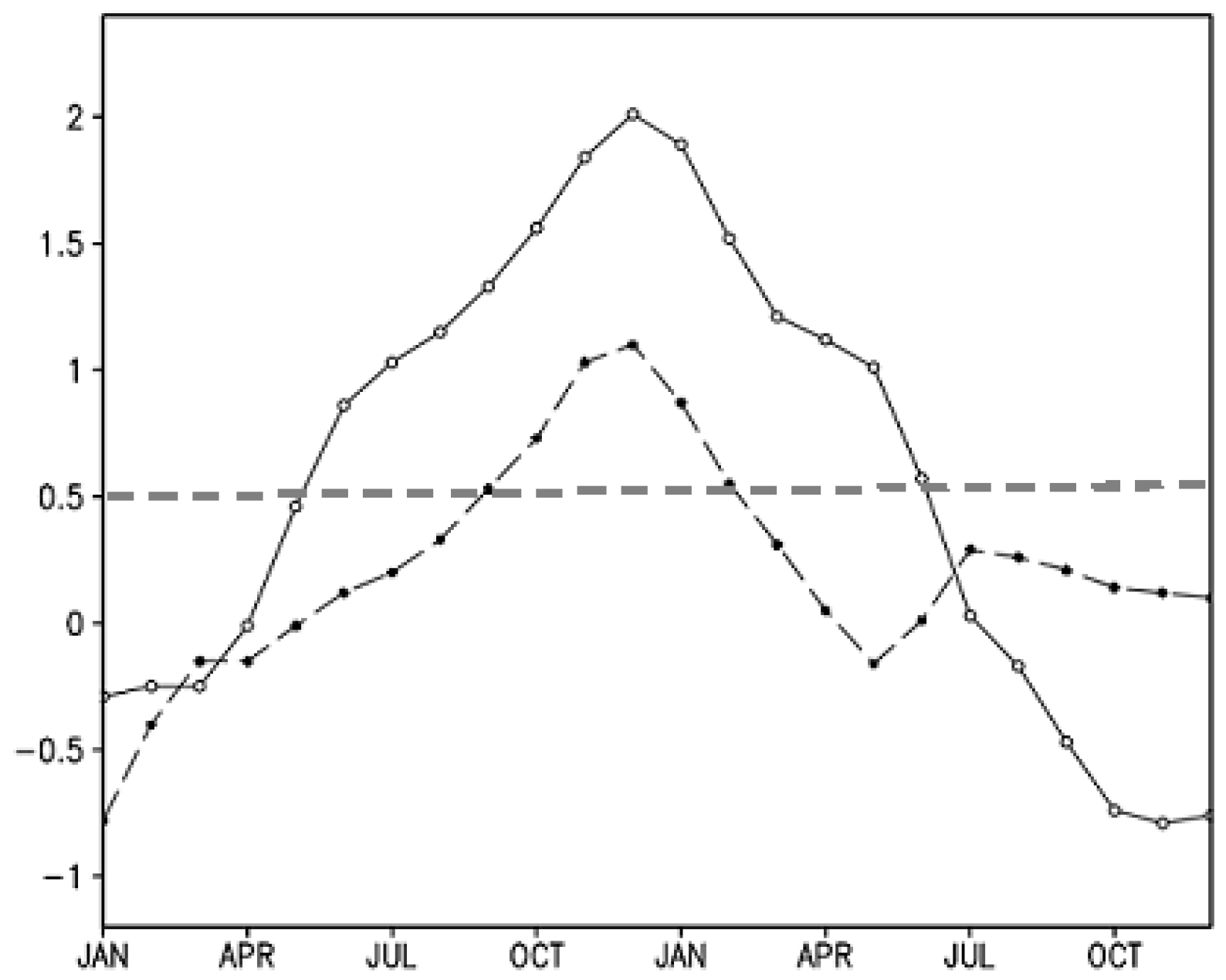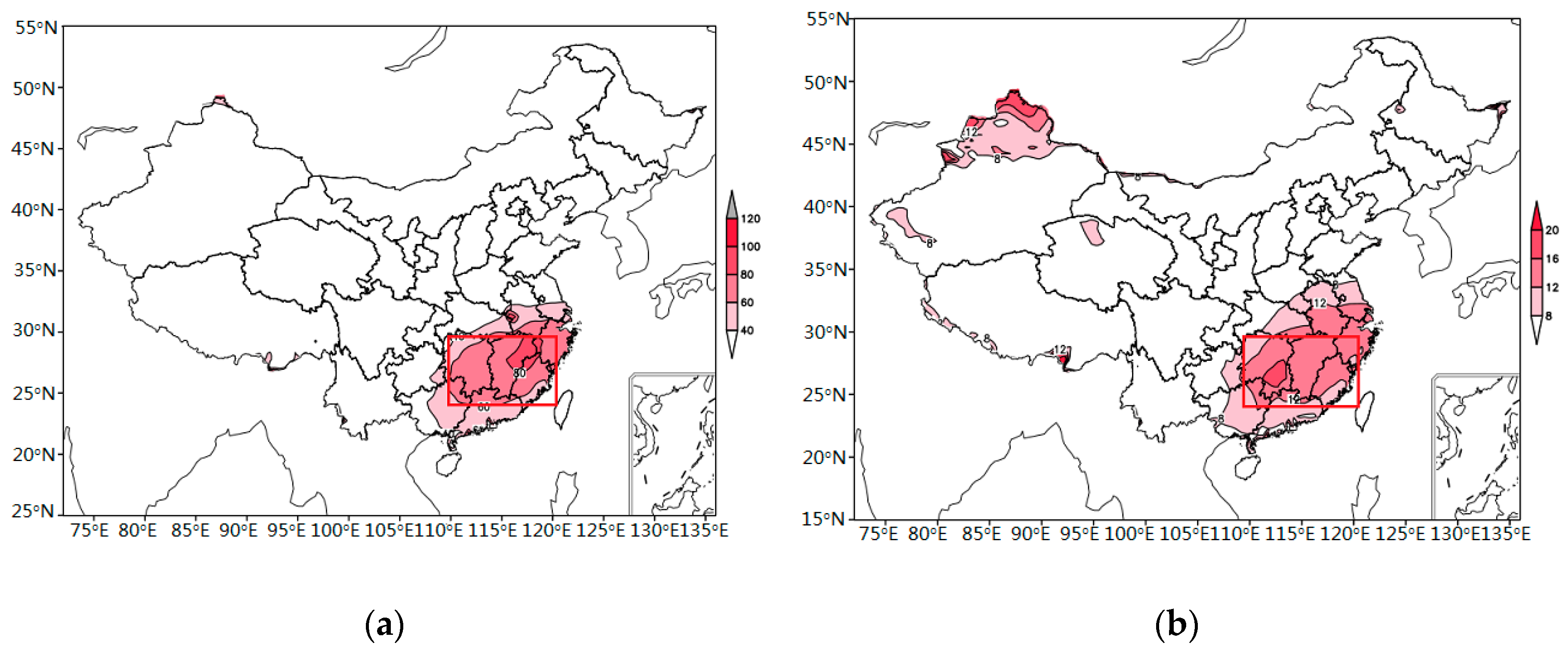Impacts of Different Onset Time El Niño Events on Winter Precipitation over South China
Abstract
:1. Introduction
2. Data and Methods
2.1. Data
- Daily precipitation data on a 0.5° × 0.5° mesh over China were obtained from the National Meteorological Information Center of the China Meteorological Administration. In the present study, South China refers to the region (22°–30° N, 108°–120° E), which covers the areas of Guangdong, Guangxi, Fujian, southern parts of Hunan, and Jiangxi. Winter (December–January–February, DJF) precipitation is defined as the average precipitation in this region.
- COBE-SST2 data, provided by NOAA/OAR/ESRL PSD, Boulder, Colorado, USA, available on a 1.0° grid [41] and obtained from https://www.esrl.noaa.gov/psd/, were used.
- The monthly mean winds, specific humidity, and geopotential height were provided by the NCEP–NCAR reanalysis dataset [42], available on a 2.5° grid and obtained from http://www.esrl.noaa.gov/psd/data/gridded/data.ncep.reanalysis.html.
- The monthly outgoing longwave radiation (OLR) data, at a resolution of 2.5°, was provided by NOAA’s National Climatic Data Center [43] and obtained from http://www.ncdc.noaa.gov.
2.2. Methods
2.3. El Niño Event Classification
3. Results
3.1. Climatic Characteristics of Winter Precipitation over South China
3.2. Possible Mechanism of the Precipitation Differences between the Spring El Niño Events and the Summer El Niño Events
3.2.1. Composite Analysis for the Influence of Tropical Ocean SST
- In the spring El Niño events, significant positive SST anomalies in the eastern equatorial Pacific (EEP) were larger, with the maximum anomaly located within 120°–140° W. In the summer El Niño events, the maximum anomaly was smaller and in the central equatorial Pacific (CEP), near the date line.
- In the spring El Niño events, significant negative SST anomalies were in the western equatorial Pacific (WEP), with a maximum value of −0.5 °C. In the summer El Niño events, the negative SST anomalies covered a bigger area.
- The east–west SST gradient of the Pacific was weaker in the summer El Niño events than in the spring El Niño events.
3.2.2. Composite Analysis for the Atmospheric Circulation
3.3. Composite Analysis for Water Vapor Transport
4. Summary and Discussion
Author Contributions
Funding
Conflicts of Interest
References
- Wang, L.; Feng, J. Two major modes of the wintertime precipitation over China. Chin. J. Atmos. Sci. 2011, 35, 1105–1116. [Google Scholar]
- Yuan, Y.; Gao, H.; Jia, X.; Wan, J. The climate impact of the super El Niño event in 2014–2016. Meteorol. Mon. 2016, 42, 532–539. (In Chinese) [Google Scholar]
- Sun, C.; Yang, S. Persistent severe drought in southern china during winter–spring 2011: Large-scale circulation patterns and possible impacting factors. J. Geophys. Res.-Atmos. 2012, 117, D10112. [Google Scholar] [CrossRef]
- Zhang, R.H.; Sumi, A.; Kimoto, M. Impact of El Niño on the East Asian monsoon: A diagnostic study of the 86/87 and 91/92 events. J. Meteorol. Soc. Jpn. 1996, 74, 49–62. [Google Scholar] [CrossRef]
- Zhang, R.H.; Sumi, A.; Kimoto, M. A diagnostic study of the impact of El Niño. Adv. Atmos. Sci. 1999, 16, 229–241. [Google Scholar] [CrossRef]
- Wang, B.; Wu, R.; Fu, X. Pacific–East Asia teleconnection: How does ENSO affect East Asian climate? J. Clim. 2000, 13, 1517–1536. [Google Scholar] [CrossRef]
- Wu, R.; Hu, Z.Z.; Kirtman, B.P. Evolution of ENSO-related rainfall Anomalies in East Asia. J. Clim. 2003, 16, 3742–3758. [Google Scholar] [CrossRef]
- Zhang, R.; Sumi, A. Moisture circulation over East Asia during El Niño episode. J. Meteorol. Soc. Jpn. 2002, 80, 213–227. [Google Scholar] [CrossRef]
- Zhou, L.; Wu, R. Respective impacts of East Asia winter monsoon and ENSO on winter rainfall in China. J. Geophys. Res.-Atmos. 2010, 115, D02107. [Google Scholar] [CrossRef]
- Yang, Q. Impact of the Indian Ocean subtropical dipole on the precipitation of east China during winter monsoons. J. Geophys. Res.-Atmos. 2009, 114, D14110. [Google Scholar] [CrossRef]
- Zhou, L.T.; Chiyung, T.; Zhou, W.; Chan, J.C.L. Influence of South China Sea SST and the ENSO on winter rainfall over South China. Adv. Atmos. Sci. 2010, 27, 832–844. [Google Scholar] [CrossRef]
- Li, C.Y. Interaction between anomalous winter monsoon in East Asia and El Niño events. Adv. Atmos. Sci. 1990, 7, 36–46. [Google Scholar]
- Tao, S.Y.; Zhang, Q.Y. Response of the Asian winter and summer monsoon to ENSO events. Chin. J. Atmos. Sci. 1998, 22, 399–407. [Google Scholar]
- Chen, W. Impacts of El Niño and La Niña on the cycle of the East Asian winter and summer monsoon. Chin. J. Atmos. Sci. 2002, 26, 595–610. [Google Scholar]
- Jin, Z.H.; Tao, S.Y. A Study on the Relationships between ENSO Cycle and rainfalls during summer and winter in eastern China. Chin. J. Atmos. Sci. 1999, 23, 663–672. [Google Scholar]
- Ni, Y.Q.; Zhou, L.; Liu, Y.; Wu, A.M.; Wang, G.M.; Yang, X.Q.; Zhang, X.D. Study for ENSO and its influences on Asian monsoon and climate change of China. Chin. J. Atmos. Sci. 1995, 15, 30–45. [Google Scholar]
- Huang, R.H.; Chen, J.L.; Wang, L.; Lin, Z.D. Characteristics, processes, and causes of the spatio-temporal variabilities of the East Asian monsoon system. Adv. Atmos. Sci. 2012, 29, 910–942. [Google Scholar] [CrossRef]
- Li, X.Z.; Liang, W.; Wen, Z.P. Characteristics of the atmosphere water vapor and its relationship with rainfall in south China in northern autumn, winter and spring. J. Trop. Meteorol. 2010, 26, 626–632. (In Chinese) [Google Scholar]
- Wang, T.; Yang, S.; Wen, Z.; Wu, R.; Zhao, P. Variations of the winter India-Burma trough and their links to climate anomalies over southern and eastern Asia. J. Geophys. Res.-Atmos. 2011, 116, D23118. [Google Scholar] [CrossRef]
- Zong, H.F.; Bueh, C.; Wei, J.; Chen, L.T. Intensity of the trough over the Bay of Bengal and its impact on the Southern China precipitation in winter. Atmos. Ocean. Sci. Lett. 2012, 5, 246–251. [Google Scholar]
- Wu, B.Y.; Huang, R.H. Effects of the extremes in the North Atlantic oscillation on East Asia winter monsoon. Chin. J. Atmos. Sci. 1999, 23, 641–651. [Google Scholar]
- Gong, D.Y.; Wang, S.W.; Zhu, J.H. East Asian winter monsoon and arctic oscillation. Geophys. Res. Lett. 2001, 28, 2073–2076. [Google Scholar] [CrossRef]
- Wu, B.Y.; Wang, J. Possible impacts of winter Arctic oscillation on Siberian High, the East Asian winter monsoon and sea-ice extent. Adv. Atmos. Sci. 2002, 19, 297–320. [Google Scholar]
- Wu, B.Y.; Wang, J. Winter Arctic oscillation, Siberian High and East Asian winter monsoon. Geophys. Res. Lett. 2002, 29, 1897. [Google Scholar] [CrossRef]
- Sung, M.K.; Lim, G.H.; Kug, J.S. Phase asymmetric downstream development of the North Atlantic oscillation and its impact on the East Asian winter monsoon. J. Geophys. Res. 2010, 115, D09105. [Google Scholar] [CrossRef]
- Fu, C.B. A review of study on El Niño/Southern Oscillation associated with the interannual climate variability. Chin. J. Atmos. Sci. 1987, 11, 209–220. [Google Scholar]
- Huang, R.H.; Wu, Y.F. The influence of ENSO on the summer climate change in China and its mechanisms. Adv. Atmos. Sci. 1989, 6, 21–32. [Google Scholar]
- Wu, R.; Wang, B. A Contrast of the East Asian Summer Monsoon-ENSO Relationship between 1962-77 and 1978-93. J. Clim. 2002, 15, 3266–3279. [Google Scholar] [CrossRef]
- Chen, J.; Wen, Z.; Wu, R.; Chen, Z.; Zhao, P. Interdecadal changes in the relationship between southern China winter-spring precipitation and ENSO. Clim. Dyn. 2014, 43, 1327–1338. [Google Scholar] [CrossRef]
- Yuan, Y.; Li, C.Y.; Yang, S. Characteristics of winter precipitation over southern China and asymmetric impact of ENSO. Acta Meteorol. Sin. 2014, 72, 237–255. [Google Scholar]
- Yasunari, T. Zonally propagating modes of the global east-west circulation associated with the Southern Oscillation. J. Meteorol. Soc. Jpn. 1985, 63, 1013–1029. [Google Scholar] [CrossRef]
- Fu, C.B.; Diaz, H.F.; Fletcher, J.O. Characteristics of the response of sea surface temperature in the central Pacific associated with warm episodes of the Southern Oscillation. Mon. Weather Rev. 1986, 114, 1716–1738. [Google Scholar] [CrossRef]
- Quinn, W.H.; Neal, V.T. El Niño occurrences over the past four and a half centuries. J. Geophys. Res. 1987, 92, 14449–14461. [Google Scholar] [CrossRef]
- Enfield, D.B.; Cid, L.S. Low-frequency changes in El Niño–Southern Oscillation. J. Clim. 1991, 4, 1137–1146. [Google Scholar] [CrossRef]
- Wang, S. Reconstruction of El Niño event chronology for the last 600-year period. Acta Meteorol. Sin. 1992, 6, 47–57. (In Chinese) [Google Scholar]
- Xu, J.J.; Chan, J.C.L. The role of the Asian-Australian monsoon system in the onset time of El Niño events. J. Clim. 2001, 14, 418–433. [Google Scholar] [CrossRef]
- Horii, T.; Hanawa, K. A relationship between timing of El Nino onset and subsequent evolution. Geophys. Res. Lett. 2004, 31, L06304. [Google Scholar] [CrossRef]
- Fan, J.F.; Meng, J.; Ashkenazy, Y.; Havlin, S.; Schellnhuber, H.J. Network analysis reveals strongly localized impacts of El Nino. Proc. Natl. Acad. Sci. USA 2017, 114, 7543–7548. [Google Scholar] [CrossRef] [PubMed]
- Timmermann, A.; An, S.I.; Kug, J.S.; Jin, F.F.; Cai, W.J.; Capotondi, A.; Cobb, K.; Lengaigne, M.; McPhaden, M.J.; Stuecker, M.F.; et al. El Niño–Southern Oscillation complexity. Nature 2018, 559, 535–545. [Google Scholar] [CrossRef] [PubMed]
- Yuan, L.; He, J.H. Different Impacts of Two Types of ENSO on Winter Rainfall over South China. Arid Meteorol. 2013, 31, 24–31. [Google Scholar]
- Hirahara, S.; Ishii, M.; Fukuda, Y. Centennial-scale sea surface temperature analysis and its uncertainty. J. Clim. 2014, 27, 57–75. [Google Scholar] [CrossRef]
- Kalnay, E.; Kanamitsu, M.; Kistler, R.; Collins, W.; Deaven, D.; Gandin, L.; Iredell, M.; Saha, S.; White, G.; Woollen, J.; et al. The NCEP/NCAR 40-year reanalysis project. Bull. Am. Meteorol. Soc 1996, 77, 437–470. [Google Scholar] [CrossRef]
- Lee, H.T.; Gruber, A.; Ellingson, R.G.; Laszlo, I. Development of the HIRS Outgoing Longwave Radiation climate data set. J. Atmos. Ocean. Technol. 2007, 24, 2029–2047. [Google Scholar] [CrossRef]









| Sequence | Duration | Last | Onset_Time | Type |
|---|---|---|---|---|
| 1 | June 1982–August 1983 | 15 | May | SP |
| 2 | October 1986–January 1988 | 16 | September | SU |
| 3 | June 1991–June 1992 | 13 | May | SP |
| 4 | May 1997–May 1998 | 13 | April | SP |
| 5 | September 2002–February 2003 | 6 | August | SU |
| 6 | September 2006–January 2007 | 5 | August | SU |
| 7 | June 2009–March 2010 | 10 | May | SP |
| 8 | April 2015–April 2016 | 13 | March | SP |
© 2018 by the authors. Licensee MDPI, Basel, Switzerland. This article is an open access article distributed under the terms and conditions of the Creative Commons Attribution (CC BY) license (http://creativecommons.org/licenses/by/4.0/).
Share and Cite
Fan, L.; Xu, J.; Guan, H. Impacts of Different Onset Time El Niño Events on Winter Precipitation over South China. Atmosphere 2018, 9, 366. https://doi.org/10.3390/atmos9100366
Fan L, Xu J, Guan H. Impacts of Different Onset Time El Niño Events on Winter Precipitation over South China. Atmosphere. 2018; 9(10):366. https://doi.org/10.3390/atmos9100366
Chicago/Turabian StyleFan, Lingli, Jianjun Xu, and Huade Guan. 2018. "Impacts of Different Onset Time El Niño Events on Winter Precipitation over South China" Atmosphere 9, no. 10: 366. https://doi.org/10.3390/atmos9100366
APA StyleFan, L., Xu, J., & Guan, H. (2018). Impacts of Different Onset Time El Niño Events on Winter Precipitation over South China. Atmosphere, 9(10), 366. https://doi.org/10.3390/atmos9100366






